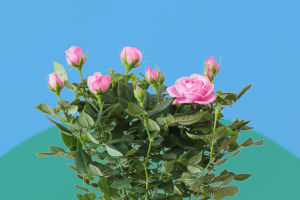Lavender is an aromatic plant belonging to the genus Lavandula in the family Labiatae and is a common ornamental and medicinal plant.
Lavender is native to the Mediterranean coastal region and is now widely cultivated around the world.
Lavender is a shrub that grows between 30cm and 1m in height. Its leaves are gray-green, long and thin, with some tiny silky hairs. The flowers are purple, shaped like spikes, and flower in the summer. You can try planting a pot of lavender at home.
The steps for growing potted lavender are as follows.
1. Choose a suitable container: Choose a deeper pot with drainage holes at the bottom to allow for the removal of excess water.
2. Buy lavender seedlings or seeds: You can go to a florist or garden center to buy lavender seedlings or seeds. If the seeds are small, you can germinate them in the pot first, and then transplant the germinated seedlings to the official pot.
3. Prepare the soil: Lavender needs to grow in soil that is loose and well-drained. You can mix clay with perlite and sand to improve the permeability and drainage of the soil.
4. Planting lavender: lay a layer of stones or broken ceramic pieces on the bottom of the pot and add some fertilizer mixed with good soil. Put lavender seedlings or seeds into the soil and cover the seeds with a small amount of soil.
5. Watering: Water moderately to keep the soil moist, but do not over-water to avoid root damage.
6. Placement: Place the pot in a sunny place and ensure at least 5-6 hours of sunlight every day. Artificial light can be used when there is not enough light indoors.
7. Waiting for growth: Lavender seeds take about 10-21 days to germinate, after which proper pruning and fertilization are needed to promote healthy plant growth.
Lavender likes a sunny, well-drained, and well-ventilated environment. If you can follow the above methods of planting and management, you can let lavender grow and thrive in your home.
Lavender has many uses.
1. Medicinal use
The medicinal value of lavender lies mainly in its essential oil. The lavender essential oil can be used to relieve anxiety, insomnia, headaches, muscle pain, infections, and other physical discomforts. In addition, the lavender essential oil can also be used as a natural antiseptic and preservative.
2. Cooking
The petals of lavender can be used in cooking to add aroma and taste to food. Common lavender foods include lavender ice cream, lavender honey, and lavender tea.
3. Beauty
The lavender essential oil can also be used as an ingredient in beauty products. Lavender essential oil can be used in skin care to relieve skin irritation, inflammation, and dryness. In addition, the lavender essential oil can also be used as an ingredient in hair care products to help control dandruff and promote hair growth.


